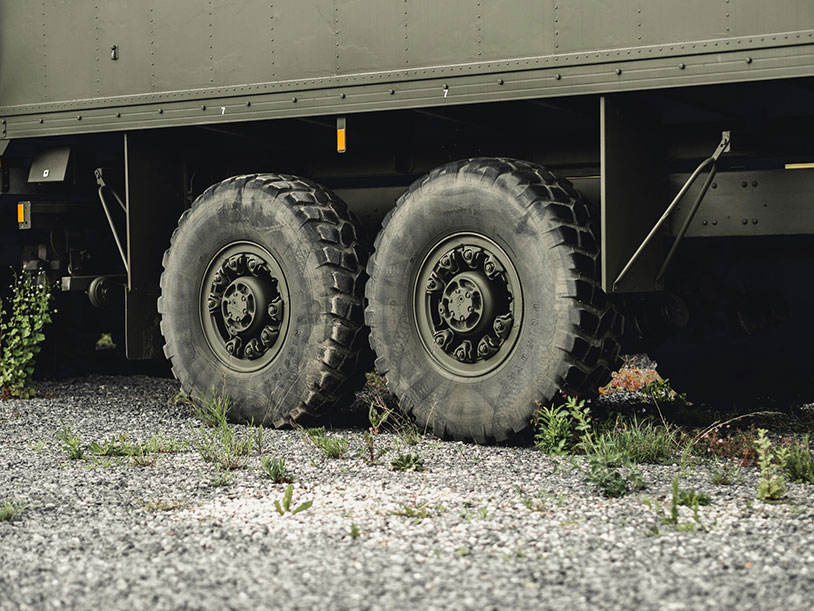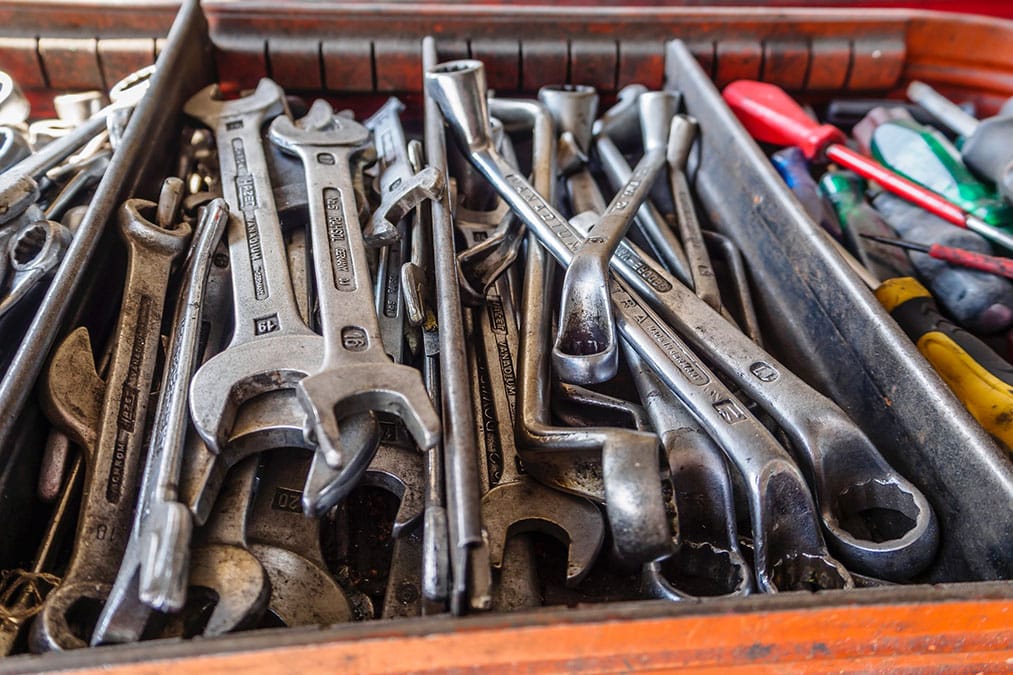In this article, I’m going to go over some basics on how to identify situations that could lead to trailer sway and discuss the installation of a sway control device called a ‘sway bar’ or ‘anti-sway bar’. For the purposes of this article, I will be referring to it simply as a ‘sway bar’.
With this knowledge and the correct gear, you should be better equipped to avoid trailer sway and keep your camping crew safe this summer.
(If you already know about trailer sway and want to skip straight to the good stuff, click on How to Install a Sway Bar on a Travel Trailer in the table of contents)
Dangers of Trailer Sway
Jackknifing
In many uncontrolled trailer sway situations, the swaying results in a jackknifing of your trailer and tow vehicle. Jackknifing refers to accidents in which the trailer has pushed into the tow vehicle, spinning the tow vehicle around while the trailer itself remains facing forward. This usually results in extreme damage to the hitches of both the tow vehicle and the trailer and some degree of body damage where the two vehicles have crunched together.
Tipping
In extreme cases of trailer sway, the violent side-to-side motions gain enough momentum to tip a trailer, sometimes taking the tow vehicle with it. I’ve seen a number of videos in which this happens, and all of them look like they would be terrifying to experience first-hand.
Not only that, but it’s unlikely to salvage a travel trailer that has been violently tipped. It can be done of course, but the rehab costs will be hefty. Good for your local RV technician, but not good for your wallet.
Check out this infamous video that demonstrates just how quickly trailer sway can occur and cause a bad highway accident:
Trailer Sway
If this is your first-time hearing about trailer sway, you might be wondering what causes it in the first place. It’s not as if the trailer can arbitrarily decide to start swaying on it’s own.
Trailer sway occurs when forces on the side of the trailer cause the trailer tires to lose traction on the road, resulting in a fishtailing action (see YouTube video above).
Depending upon the amount of force put on the side of the trailer, and the reaction of the driver, this fishtailing can build momentum and lead to one of the accidents described above. Not fun.
Causes of Trailer Sway.
Here are some of the hazards to keep an eye out for while towing a trailer.
- Heavy winds: when winds blow perpendicular to the road, your trailer acts as a sail and can easily lose traction on the roadway.
- Snow/rain/ice: any weather conditions that make the surface of the road more slippery than normal can cause the travel trailer to sway.
- Passing large vehicles: large trucks on the highway create tremendous amounts of powerful wind as they cut through the air. These artificial winds can be enough for your trailer to start fishtailing after passing a large rig.

- Improper weight distribution: it is critical to be intentional with weight distribution when loading a trailer. Having too much weight in the front of the trailer, or too much weight in the rear can lead to violent trailer sway.
- Low Tire Pressure: low tire pressure will decrease the load capacity of both you trailer and your tow vehicle. Make sure your tires are inflated properly before hitting the road.

Preventing Travel Trailer Sway
Nowadays, there are a couple of nifty contraptions available to help prevent travel trailer sway from occurring in the first place.
Weight Distribution Hitch
A weight distribution hitch does exactly what it sounds like it would do. This specialized hitch helps to keep both your trailer and tow vehicle parallel with the surface of the road. This prevents sag in the rear of the tow vehicle, which has been known to cause and perpetuate fishtailing.
These hitches also have sway control bars that aid in keeping the trailer centered behind the vehicle.
Sway Bar
A sway bar is relatively cheap and easy to install aftermarket parts for your hitch system. They perform best on small to medium-sized trailers and most are compatible with almost all makes and models of tow vehicles and trailers.
Please note that a sway bar is different than the sway control bars found on weight distribution hitches.
A sway bar works by creating a point of friction between your tow vehicle and your trailer. This friction creates resistance to the small fishtailing actions that can lead to bigger trailer sway. The beauty of these devices is that they reduce swaying motions while still allowing your trailer and vehicle to move independently of each other while turning.
How to Install a Sway Bar on a Travel Trailer
I might draft another article describing the installation of weight distribution hitches at a different time, but today I am going to focus on the installation of sway bars.
Tools Needed

Lucky for us, installing a sway bar system on your tow vehicle and trailer is a straightforward process. With that said, you will need some power tools and a couple of hand tools to get the job done:
- Pencil or permanent marker
- Tape measure
- Drill with metal cutting drill bits
- Metal cutting fluid
- Impact driver with socket attachments
- Wrench set
Installation
Step one of the installation process will be to open up your new sway bar kit and take a look at the pieces provided. You should find the following items in the kit:
- Slide bar/friction plate
- Ball assembly (ball, nuts, and washers)
- Ball mounting plate
- Spring clips
- Self-tapping screws
- Weld-on tab for mounting ball assembly (sometimes)
Installing sway bars on a trailer can help reduce the risk of swaying or fishtailing while towing. Here are the steps to install sway bars on your trailer:
Step 1: Attach the hitch sway control ball to the tow vehicle’s hitch receiver.
Step 2: Measure the distance between the hitch sway control ball and the trailer’s tongue, and then locate and mark the spot on the trailer’s tongue where the trailer sway control ball will be installed.
Step 3: Drill pilot holes into the trailer’s tongue at the marked spot using a drill bit of the appropriate size.
Step 4: Bolt the trailer sway control ball into place using bolts and washers, tightening them securely.
Step 5: Attach the sway control bar to the trailer sway control ball and then to the hitch sway control ball on the tow vehicle. Make sure the sway control bar is tightened securely and is level with the ground.
Step 6: Test the sway control unit by towing your trailer on a straight, level road at various speeds. Make sure the sway control bar is working properly and keeping the trailer stable. If necessary, adjust the sway control unit to ensure optimal performance.
By providing additional information about the benefits of installing sway bars and including specific details about each step, you increase the likelihood that Google will choose your content for the featured snippet.
There you have it! Pretty easy, huh?
If you prefer a visual demonstration, check out this great step-by-step installation video by YouTuber, Doing Things Dan’s Way. His video details an almost identical installation process to the one I described above, and he does an excellent job explaining the minute details.
Last Tips
In order to make the sharp, precise adjustments necessary to park a trailer, you’ll need to remove the sway bar before reversing with your trailer.
As Dan points out in the video linked above, the sway bar has the potential to pinch in between the trailer and the ground when raising and lowering your trailer. Make sure not to let this pinching happen so as to not damage your sway bar, trailer, tow vehicle, or yourself.
Do not assume you are 100% safe from trailer sway now that you have an anti-sway device. Always drive cautiously, be smart and thoughtful when loading weight into your trailer and keep a level head if you do feel the beginnings of trailer sway. Give this article a read if you are curious about how to safely respond when trailer sway occurs.
Conclusion
Whether you have an enormous luxury camper or an itty-bitty travel trailer, the dangers of trailer sway are always present. It doesn’t matter how many years you’ve been towing trailers, or how big or small your rig is. If you tow a trailer, you put yourself at risk of encountering trailer sway. So, equip yourself with the right gear and knowledge in order to mitigate the risks of towing.
Should you decide to purchase yourself an anti-sway bar, I hope this article has helped you to understand the installation process a bit better. Drive safe friends and happy camping!



